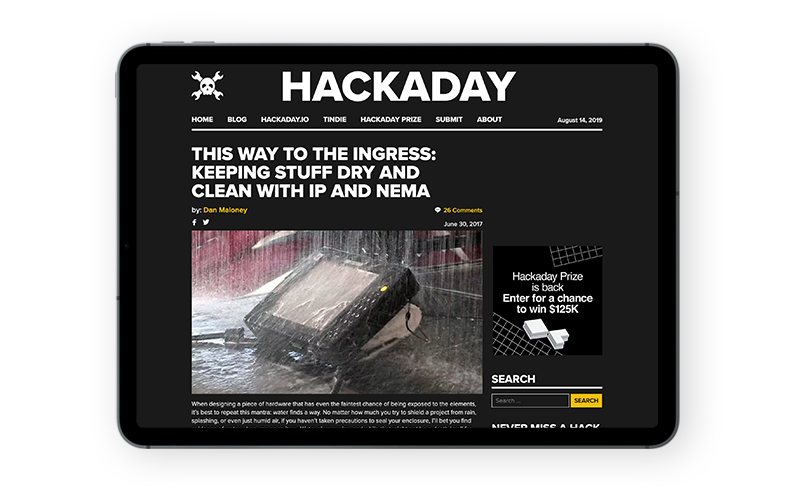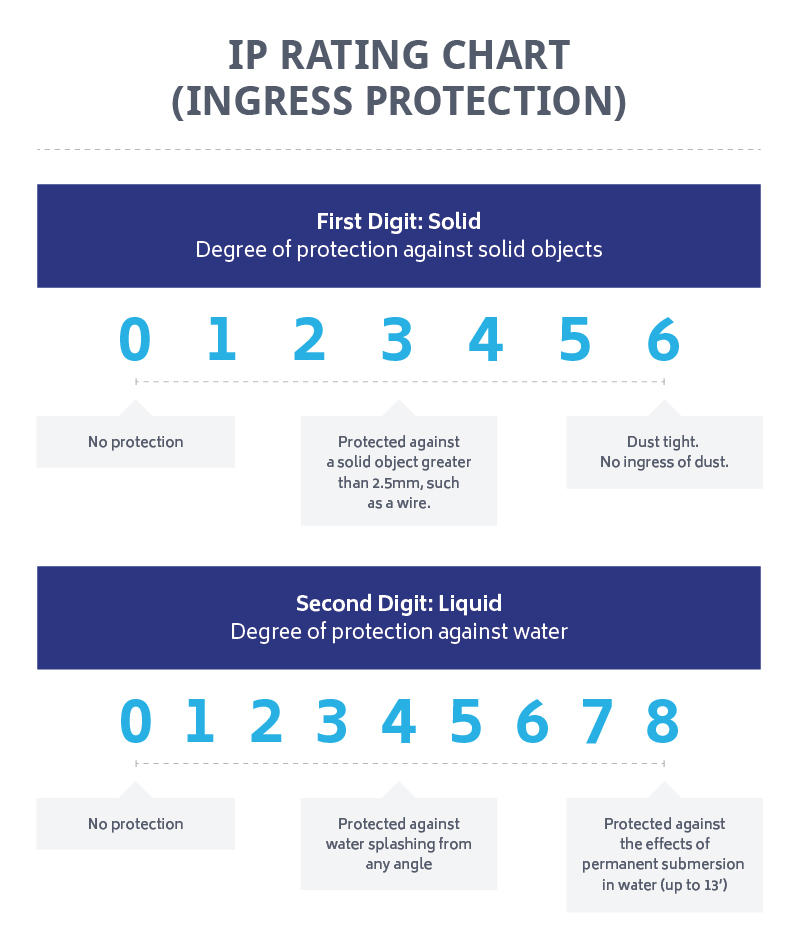Tangents
What is an IP (Ingress Protection) Rating?
by Joe Schappler

[wtr-time]
Tasked with designing products able to withstand extreme conditions, you need to factor in a product’s protection against intrusion from foreign materials and moisture, which is determined by its IP Rating.
To that end, we’ve created a comprehensive explanation of what an IP rating or Ingress Protection Rating is, which we hope will help you with your designs, but also when explaining your design choices to clients.
What does IP rating mean? Why does an IP rating matter to you, your products, and your business? With respect to design integrity and client communication, it’s helpful to review the importance of IP ratings.
Why Should I Care About an IP Rating?
While not a particularly exciting aspect of industrial design, IP rating is critical when determining how waterproof or water-resistant a product is, or (as anyone who’s ever dropped their phone in water will attest), is not.
As Dan Maloney explains in This Way to the Ingress: Keeping Stuff Dry and Clean with IP and NEMA:
When designing a piece of hardware that has even the faintest chance of being exposed to the elements, it’s best to repeat this mantra: water finds a way. No matter how much you try to shield a project from rain, splashing, or even just humid air, if you haven’t taken precautions to seal your enclosure, I’ll bet you find evidence of water when you open it up. Water always wins, and while that might not be a death knell for your project, it’s probably not going to help.
A product’s IP rating features in popular questions like, How Waterproof is Your Android Phone or iPhone? The answer influences consumer choice and is determined ahead of production by designers who evaluate the conditions a product can reasonably withstand and still function.
Of course, IP ratings extend to industrial applications far larger than a personal device like a phone or tablet. This is where knowing your IP ratings inside and out streamlines your design efforts for a flawless finished product.
IP Rating by Definition
A standard determined by the International Electrotechnical Commission, a product’s Ingress Protection Rating or International Protection Rating, more commonly known as an IP rating, is “used to define levels of sealing effectiveness of electrical enclosures against intrusion from foreign bodies (tools, dirt etc) and moisture,” according to The Enclosure Company.
In other words, an IP rating tells you “the extent of protection an electrical enclosure has against environmental conditions.”
These conditions include accidental and intentional exposure to solids (hands, tools, foreign bodies, etc.) and moisture, which ranges from a few raindrops to total immersion in a body of water.
Why Not Just Label it “Waterproof?”
If the point of an IP rating is to demonstrate how well a product can hold up against moisture, for example, why can’t industrial designers just rely on labels like “waterproof” or “water-resistant?”
As stated in The Comprehensive Guide to IP Ratings, “The reason for having a universal IP rating system is so that buyers and users can be confident of how safe it is to use certain electrical or mechanical goods in specific environments and applications.”
After all, the term “waterproof” is often indicative of nothing more than a marketing move, and does not “necessarily give a clear definition of precisely where and to what extent an item can resist moisture ingress – an IP rating is designed to provide a far more specific account.”
Or, as Maloney reminds designers, “Before international standards for protection, any manufacturer could slap a label on device claiming it was “waterproof” or “dustproof” and get away with it.”
A Handy Cheat Sheet for Your Clients
When evaluating a product’s IP rating, you’ll see two numbers occasionally followed by a single letter. The first numeral concerns solids and the second relates to liquids, specifically water. Remember the word ingress just means entryway, so you want to check a product’s IP rating to see how tightly sealed it is from letting in moisture or small fragments like dust particles.
By way of illustration, let’s review two common IP ratings — IP67 and IP68 — to find out what they actually mean with respect to industrial design and concerned consumers.
IP67
If you’re shopping for smartphones and want to know how waterproof or water resistant (these are two different realities) your potential purchase is, an IP67 rating “means the unit can be dropped into a body of water up to a meter deep for half an hour.”
To clarify, by “body of water” the IEC strictly means water. So, if you’re pounding away on your laptop and accidentally tip your morning coffee over and onto your phone, you’ll want to clean up that mess, pronto.
IP68
For maximum protection against water, focus on products with an IP rating of 68. Why? Of all the IP ratings, “IP68 is the highest rating you can get when it comes to protecting your phone from foreign objects (solid resistance goes up to a high of 6 while liquids are marked on a scale of 0-8, with bigger numbers equalling better protection).”
Similar to IP67, a “liquid” in this case is also restricted to fresh water. In other words, if you’re on vacation and your phone slips into the surf, you’ll need to rinse it with fresh water and then dry it to clean out any salt that could clog the microphone or other mechanisms.
Analyzing Ingress Codes
A shortcut to analyzing ingress codes or IP ratings is to remember the expression, “the bigger the better.”
As our colleagues across the pond at Heatingpoint explain about ingress codes:
0” indicates that a product has no protection from water ingress, whilst at the opposite end of the scale, “8” represents a product that can be fully immersed in water for long periods of time. Level 9 indicates resistance to highly pressurised, high temperature water and is only used in specific industrial applications, so it is unlikely you will find this applied to a domestic product.
The Addition of an Alpha Character
Earlier, we mentioned that IP ratings sometimes include a letter, as well as the two numerals representative of solids and liquids. For instance, you might encounter an IP rating that includes an X. The placement of that X indicates that the product was never officially tested for ingress in the liquid or solid category.
If it comes first, as in IPX5, the solids were never tested. Similarly, an IP rating of IP4X means that the product was never tested for liquid ingress; it’s not considered water-resistant or waterproof in this case. This means you cannot assume any level of protection from exposure to liquids.
Reminders About IP Ratings
Although it seems simple enough to evaluate an IP rating when discussing how water resistant or waterproof the latest cell phone might be, there is more to IP ratings with respect to design. After all, water isn’t the only intrusive force that could compromise a device.
Maloney is quick to caution designers, “Particle intrusion can be a real killer too, especially in an environment where dust can be conductive.”
Remember, just as 8 is the highest rating for protection against liquids, 6 represents the pinnacle of protection against solids of any kind, including dust.
As a designer, understanding the intricacies of IP ratings is imperative to the success of your designs and central to customer satisfaction.
Do you have a new idea for a product that needs to withstand extreme environmental conditions? Are you unsure of how to meet Ingress Protection Rating requirements? We can help you. Please drop me a note on chat to get your questions answered today.
About Helix Design
Helix Design is an industrial design firm and product design company that delivers creative design and mechanical engineering solutions to companies who need external perspectives combined with practical experience. For samples of our recent work, please visit our industrial design portfolio.
Do you need industrial design guidance for your next project?
Contact us for an assessment today.





